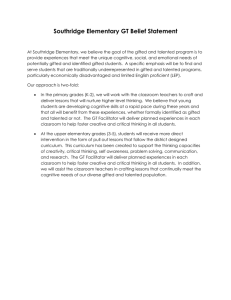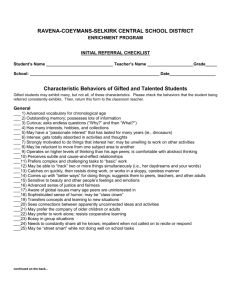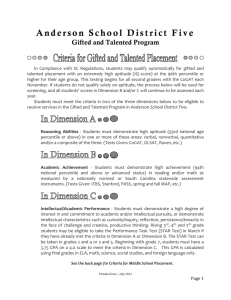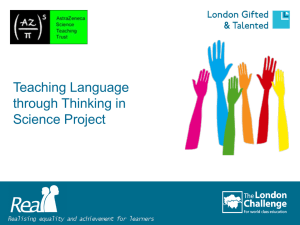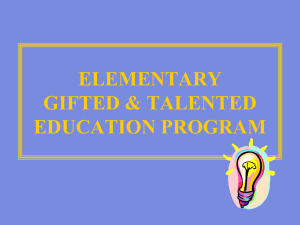Why Take the Needs of Gifted and Talented Students Seriously
advertisement
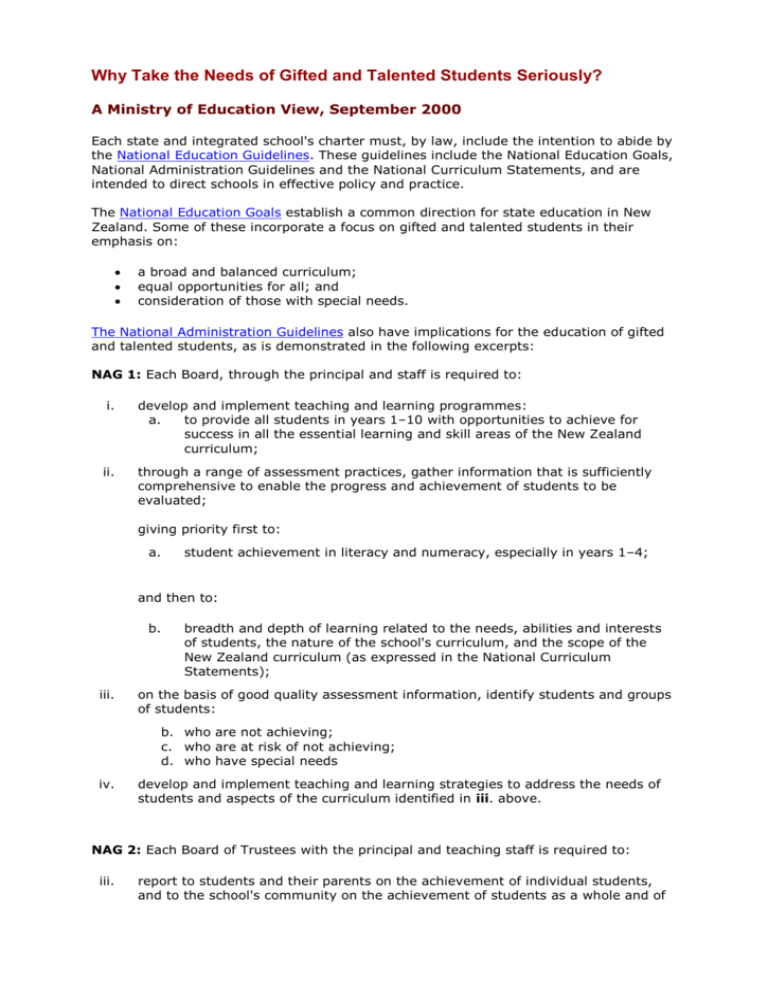
Why Take the Needs of Gifted and Talented Students Seriously? A Ministry of Education View, September 2000 Each state and integrated school's charter must, by law, include the intention to abide by the National Education Guidelines. These guidelines include the National Education Goals, National Administration Guidelines and the National Curriculum Statements, and are intended to direct schools in effective policy and practice. The National Education Goals establish a common direction for state education in New Zealand. Some of these incorporate a focus on gifted and talented students in their emphasis on: a broad and balanced curriculum; equal opportunities for all; and consideration of those with special needs. The National Administration Guidelines also have implications for the education of gifted and talented students, as is demonstrated in the following excerpts: NAG 1: Each Board, through the principal and staff is required to: i. develop and implement teaching and learning programmes: a. to provide all students in years 1–10 with opportunities to achieve for success in all the essential learning and skill areas of the New Zealand curriculum; ii. through a range of assessment practices, gather information that is sufficiently comprehensive to enable the progress and achievement of students to be evaluated; giving priority first to: a. student achievement in literacy and numeracy, especially in years 1–4; and then to: b. iii. breadth and depth of learning related to the needs, abilities and interests of students, the nature of the school's curriculum, and the scope of the New Zealand curriculum (as expressed in the National Curriculum Statements); on the basis of good quality assessment information, identify students and groups of students: b. who are not achieving; c. who are at risk of not achieving; d. who have special needs iv. develop and implement teaching and learning strategies to address the needs of students and aspects of the curriculum identified in iii. above. NAG 2: Each Board of Trustees with the principal and teaching staff is required to: iii. report to students and their parents on the achievement of individual students, and to the school's community on the achievement of students as a whole and of groups (identified through 1 iii. above) including the achievement of Maori students against the plans and targets referred to in 1 v. above. The New Zealand Curriculum Framework states principles which give direction to the curriculum in schools. The following principles take into account the needs of gifted and talented students: The New Zealand Curriculum fosters achievement and success for all students. At each level, it clearly defines the achievement objectives against which students' progress can be measured. The school curriculum will provide learning opportunities which will enable all students to achieve the learning objectives to the best of their ability. Schools will provide professional and innovative teaching, supported by resources of the highest possible quality. The New Zealand Curriculum provides for flexibility, enabling schools and teachers to design programmes which are appropriate to the learning needs of their students. The school curriculum will be sufficiently flexible to respond to each students' learning needs, to new understanding of the different ways in which people learn The New Zealand Curriculum provides all students with equal educational opportunities. The school curriculum will recognise, respect, and respond to the educational needs, experiences, interests, and values of all students: both female and male students; students of all ethnic groups; students with different abilities and disabilities The New Zealand Curriculum Framework also specifies eight groupings of essential skills to be developed across the whole curriculum, and the description of these acknowledges the different needs of gifted and talented students: The curriculum will challenge all students to succeed to the best of their ability. Individual students will develop the essential skills to different degrees and at different rates. Some of the skills also embody areas of probable strength for gifted and talented students, and provide a basis for challenging enrichment programmes. Problem-solving skills: students will think critically, creatively, reflectively and logically; students will exercise imagination, initiative, and flexibility; and students will try out innovative and original ideas. Self-management and competitive skills: students will set, evaluate, and achieve realistic personal goals; students will show initiative, commitment, perseverance, courage and enterprise; students will develop constructive approaches to challenge and change, stress and conflict, competition, and success and failure. Work and study skills: students will work effectively, both independently and in groups students will build on their own learning experiences, cultural backgrounds, and preferred learning styles. Most of the National Curriculum Statements also refer to the importance of a special focus on gifted and talented students, within the parameters of the achievement objectives: The Arts Programmes should extend and challenge students who are gifted or talented in the arts disciplines. Students may, for example, work towards achievement objectives at higher levels or take part in more complex and challenging learning experiences than their peers. Gifted and talented students may demonstrate exceptional abilities in a wide range of art forms, many of which have not traditionally received recognition. Schools should seek to identify such students as early as possible in their development, provide them with supportive learning experiences and environments, and devise assessment methodologies appropriate to their learning. The Ministry of Education publication Gifted and Talented Students: Meeting their Needs in New Zealand Schools provides information to assist in this process. English The aims and objectives described in this curriculum statement provide goals and challenges for all, including gifted and talented students. Teachers should adapt learning contexts to stimulate and extend these students. Many of the learning and teaching examples suggest contexts for acceleration and enrichment – for instance, the processes and knowledge needed for complex language activity or research, and the emphasis on individual challenge, experiment, and excellence. The curriculum's openness with regard to the choice of literary texts also offers opportunity for challenge and extension to students with special language abilities. Health and Physical Education Students who have exceptional ability in health education and physical education … require programmes that extend them, challenge them, and broaden their abilities. These groups of students need programmes adapted and organised to provide access to relevant opportunities, meet their individual needs, and contribute to the development of their awareness of their personal identity and their sense of self-worth. It is important that students with special needs and abilities: are identified early; have their learning needs addressed from the beginning, through relevant and consistent programmes; work at their own pace; work towards goals and challenges that encourage them to develop to their full potential; are valued by their peers, their teachers, the school, and the wider community; and help to plan programmes to meet their particular learning needs. Mathematics …students with exceptional ability in mathematics must be extended and not simply expected to repeat different permutations of work they have clearly mastered. Some students develop faster in all aspects of mathematics than most of their peer group. Other students reach a particular achievement level in one strand or topic sooner or faster than most of their peer group without necessarily being equally competent in all other strands at the same level. A levels structure may be thought to imply that faster students should automatically be accelerated to the next level. This is not necessarily so, nor is it the aim of this curriculum. Teachers should carefully appraise the experience and needs of students before deciding to move them to the next level. It is very important, however, that students do not have their mathematical development inhibited by, for example, repeating work which they have sclearly mastered. The intention of the development band is to encourage teachers to offer broader, richer, and more challenging mathematical experiences to faster students. Work from the development band should allow better students to investigate whole new topics which would not otherwise be studied and to work at a higher conceptual level. Talented students should have their interest in mathematical ideas further stimulated and their understanding of the nature of mathematics deepened. Teaching approaches which may build on the interest of students include: allowing students themselves to select the topic or content they wish to pursue and to set their own goals; allowing the opportunity for individual and independent study, perhaps using a contract plan; and encouraging access to a broader range of higher level resources. Science School and classroom programmes in science need to identify and nurture students with special abilities in science. When used flexibly, the curriculum offers talented students both acceleration and enrichment. An inclusive curriculum in science provides opportunities for students with special abilities to: School and classroom programmes in science need to identify and nurture students with special abilities in science. When used flexibly, the curriculum offers talented students both acceleration and enrichment. An inclusive curriculum in science provides opportunities for students with special abilities to: have their special ability in science valued by their peers, their teachers, their families, and the wider community; develop their knowledge and skills at their own pace; engage in learning activities which encourage higher-order thinking skills, such as analysis, evaluation, and synthesis; learn through open-ended activities which encourage imaginative and creative thinking and lateral exploration of ideas; use co-operative and problem-solving approaches to learning; communicate their ideas with others of similar ability.

